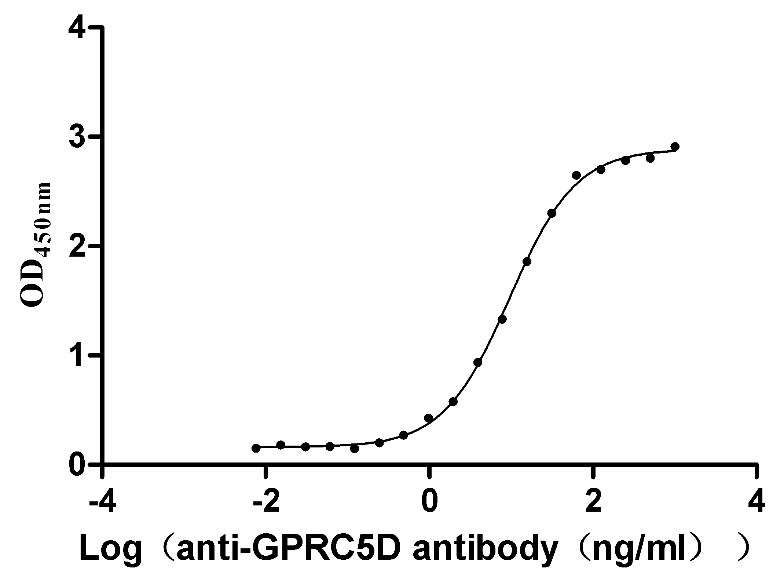Recombinant Sindbis virus Non-structural polyprotein, partial
-
中文名称:
-
货号:CSB-YP361019SHZc7
-
规格:¥2616
-
图片:
-
其他:
产品详情
-
纯度:Greater than 90% as determined by SDS-PAGE.
-
基因名:N/A
-
Uniprot No.:
-
种属:Sindbis virus (SINV)
-
蛋白长度:Partial
-
来源:Yeast
-
分子量:62.4 kDa
-
表达区域:1348-1896aa
-
氨基酸序列APSYRTKRENIADCQEEAVVNAANPLGRPGEGVCRAIYKRWPTSFTDSATETGTARMTVCLGKKVIHAVGPDFRKHPEAEALKLLQNAYHAVADLVNEHNIKSVAIPLLSTGIYAAGKDRLEVSLNCLTTALDRTDADVTIYCLDKKWKERIDAALQLKESVTELKDEDMEIDDELVWIHPDSCLKGRKGFSTTKGKLYSYFEGTKFHQAAKDMAEIKVLFPNDQESNEQLCAYILGETMEAIREKCPVDHNPSSSPPKTLPCLCMYAMTPERVHRLRSNNVKEVTVCSSTPLPKHKIKNVQKVQCTKVVLFNPHTPAFVPARKYIEVPEQPTAPPAQAEEAPEVVATPSPSTADNTSLDVTDISLDMDDSSEGSLFSSFSGSDNSITSMDSWSSGPSSLEIVDRRQVVVADVHAVQEPAPIPPPRLKKMARLAAARKEPTPPASNSSESLHLSFGGVSMSLGSIFDGETARQAAVQPLATGPTDVPMSFGSFSDGEIDELSRRVTESEPVLFGSFEPGEVNSIISSRSAVSFPLRKQRRRRRSRRTEY
Note: The complete sequence including tag sequence, target protein sequence and linker sequence could be provided upon request. -
蛋白标签:C-terminal 6xHis-tagged
-
产品提供形式:Liquid or Lyophilized powder
Note: We will preferentially ship the format that we have in stock, however, if you have any special requirement for the format, please remark your requirement when placing the order, we will prepare according to your demand. -
缓冲液:If the delivery form is liquid, the default storage buffer is Tris/PBS-based buffer, 5%-50% glycerol. If the delivery form is lyophilized powder, the buffer before lyophilization is Tris/PBS-based buffer, 6% Trehalose.
-
复溶:We recommend that this vial be briefly centrifuged prior to opening to bring the contents to the bottom. Please reconstitute protein in deionized sterile water to a concentration of 0.1-1.0 mg/mL.We recommend to add 5-50% of glycerol (final concentration) and aliquot for long-term storage at -20℃/-80℃. Our default final concentration of glycerol is 50%. Customers could use it as reference.
-
储存条件:Store at -20°C/-80°C upon receipt, aliquoting is necessary for mutiple use. Avoid repeated freeze-thaw cycles.
-
保质期:The shelf life is related to many factors, storage state, buffer ingredients, storage temperature and the stability of the protein itself.
Generally, the shelf life of liquid form is 6 months at -20°C/-80°C. The shelf life of lyophilized form is 12 months at -20°C/-80°C. -
货期:Delivery time may differ from different purchasing way or location, please kindly consult your local distributors for specific delivery time.
-
注意事项:Repeated freezing and thawing is not recommended. Store working aliquots at 4°C for up to one week.
-
Datasheet & COA:Please contact us to get it.
相关产品
靶点详情
-
功能:Inactive precursor of the viral replicase, which is activated by cleavages carried out by the viral protease nsP2.; The early replication complex formed by the polyprotein P123 and nsP4 synthesizes minus-strand RNAs. Polyprotein P123 is a short-lived polyprotein that accumulates during early stage of infection. As soon P123 is cleaved into mature proteins, the plus-strand RNAs synthesis begins.; The early replication complex formed by the polyprotein P123' and nsP4 synthesizes minus-strand RNAs (Probable). Polyprotein P123' is a short-lived poly...显示更多
-
基因功能参考文献:
- plays an important role in regulating Sindbis virus-induced type I interferon responses PMID: 20097400
- These results implicate nsP2 in regulation of minus-strand synthesis and suggest that different regions of the nsP2 MTase-like domain differentially modulate host defense mechanisms, independent of its role as the viral protease. PMID: 18495773
- The nsP2-726 Pro residue regulates virus-host cell interactions directly and is also important in viral pathogenesis. PMID: 19428754
- These results show that nsP2 (and possibly nsP3) possesses functions other than those needed solely for replication-transcription complex (RTC) activity and that it may also act to regulate minus-strand synthesis and the stability of the RTC. PMID: 19515769
- PARP-1 interacts with the C-terminal domain of nsP3 during virus amplification. PMID: 19515826
- results revealed new information about the structure of SINV nsP2 and interaction of its domains PMID: 19570872
收起更多
-
亚细胞定位:[Polyprotein P1234]: Host cytoplasmic vesicle membrane; Peripheral membrane protein.; [Polyprotein P123']: Host cytoplasmic vesicle membrane; Peripheral membrane protein.; [Polyprotein P123]: Host cytoplasmic vesicle membrane; Peripheral membrane protein.; [mRNA-capping enzyme nsP1]: Host cytoplasmic vesicle membrane; Lipid-anchor. Host cell membrane; Lipid-anchor; Cytoplasmic side. Host cell projection, host filopodium.; [Protease nsP2]: Host cytoplasmic vesicle membrane; Peripheral membrane protein. Host nucleus. Host cytoplasm.; [Non-structural protein 3]: Host cytoplasmic vesicle membrane; Peripheral membrane protein.; [Non-structural protein 3']: Host cytoplasmic vesicle membrane; Peripheral membrane protein.; [RNA-directed RNA polymerase nsP4]: Host cytoplasmic vesicle membrane; Peripheral membrane protein.
-
数据库链接:
KEGG: vg:1502154





-AC1.jpg)















